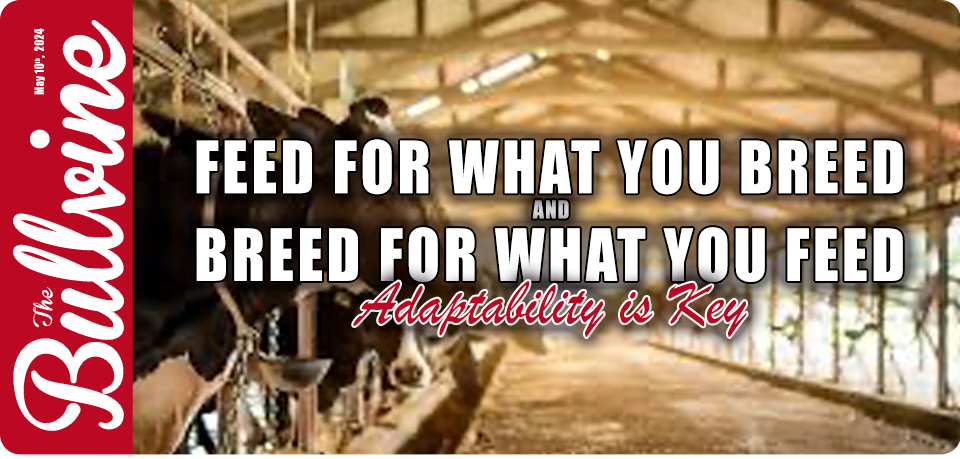Discover how strategic cow breeding and facility management can boost your dairy farming. Adapt to your environment for optimal results. Are you ready to evolve?

In the world of dairy farming, the cornerstone of successful operation lies in shrewd decision-making and achieving an ideal equilibrium. As a dairy farmer, the art of adaptability is one skill that you cannot afford to lack. This central notion is crisply encapsulated by the phrase “feed for what you want to breed or breed for what you want to feed”. But what exactly does this timeless adage symbolize, and why does it bear such critical relevance in contemporary farming techniques? Allow us to unravel the mystery behind these words and shed light on their substantial implications for your dairy farming activities.
Recently, Cliff Shearer, an insightful Jersey breeder from Hawera in New Zealand, shared this adage in a discussion in The Milkhouse, a private Facebook group for dairy breeders around the world about why dairymen spend more money on feeding than they do genetics and got me thinking about just how true this old adage is even for modern breeding.
The Essence of the Concept
Picture this philosophy as laying its foundation on a simple premise: dairy farmers should breed cows that are ideally suited for the environment they possess. This perspective puts a spotlight on the importance of creating facilities and designing programs specifically tailored to the cows in your care. Seem intense? Consider this profound mantra, “feed for what you want to breed or breed for what you want to feed.” Think of this saying as your guiding star, emphasizing the pillars of sustainability and adaptability—two symbiotic elements vital for a booming dairy farm.
Upholding the Mantra in Dairy Farming
Several reasons validate the importance of this mantra. At the top of the list:
- Economic sustainability and ecological responsibility: Breeding cows that naturally fit into their intended environment promotes the breed’s growth, mitigates health issues, and optimizes milk production.
- Improved cow welfare and disease prevention: Building facilities and developing feeding programs with the specific cows in mind leads to enhanced animal health, fewer disease occurrences, and consequently, increased productivity.
- Systematic and efficient farm management: This methodology nurtures a cyclical process in farming. To put it simply, the resources you pour into the environment get returned as outputs from the cows, promoting efficiency and balance.
Taking the time to adapt to the types of cattle and the environment you work with plays a massive role in any dairy farm’s triumph. Goodbye to the “one size fits all” approach, and hello to a tailored, precise fit!
Breeding Cows for Your Specific Environment
As a dairy farmer, maximizing the efficiency and productivity of your herd is fundamental. Yet, there’s a secret weapon that can dramatically enhance this efficiency – it lies in expertly matching the cows you breed with the environmental conditions and feeding programs of your farm. Yes, you got it right! Each step you take to ensure this unique alignment amplifies the health and fitness of your cows.
- Extracting the Best from Your Environment
Consider this. Certain cow breeds perform better than others, depending on your farm’s climate, topography, and even the type of vegetation. By selecting breeds that naturally adapt to your environmental conditions at ease, you can ensure that their growth and production rates remain at their prime. By honing in on this unique understanding and taking advantage of it, you could be on the brink of revolutionizing your whole dairy venture. - Tailoring Your Feeding Programs
The same principle can be applied to your feeding programs. It’s no secret that breeds differ in their nutrient demands, digestive capabilities, and feed conversion efficiencies. Balancing these characteristics with the type and quality of feed available to you could have a profound impact on your venture.
Whether it’s a Holstein thriving on high-quality forages or a Jersey efficiently utilizing lower-quality feed, the choice of breed remains integral within your farming enterprise. Embrace this challenge! The road towards achieving this balance may seem challenging, but stepping onto it is your first move towards an optimized and robust dairy farm future. So, partner up with nature, let the environment guide your breed selection, and watch your dairy farm flourish!
Building Your Environment for the Type of Cows You Wish to Breed
Once you’ve chosen the type of cows you wish to breed, it’s pivotal to step forward and develop an environment and feeding programs that synchronize with your herd’s characteristics. These are more than mere considerations; they are pillars of your breeding program’s success and your herd’s overall health and productivity.
Creating a Favorable Environment
In the spirit of creating a suitable environment, it’s essential to conduct a fine assessment of the infrastructure required to support your chosen breed. Factors such as barn size, pasture space, availability of clean water, and appropriate fencing can significantly influence the well-being and productivity of your cows.
If your breed of choice is one that thrives in cold temperatures, your facilities might need to incorporate barn heating systems for the chillier seasons. On the flip side, if your chosen breed prefers warmer climates, shaded areas or cooling systems could be considerable investments. Remember, adequately preparing your farm before introducing your cows is vital to their thriving and ultimate success.
For instance, those who choose to raise beef cattle need to ensure access to sturdy fencing, well-drained pastures for grazing, reliable water sources, and robust shelter to protect the herd from inclement weather conditions. These resources cater specifically to the needs of raising meat-producing bovines and significantly contribute to their growth and productivity.
Designing Appropriate Feeding Programs
Coming parallel to environmental concerns, designing a strategic feeding program that aligns with the dietary requirements of your preferred breed is essential. Different breeds have distinct dietary needs, and your feed programs must reflect these specifics to maintain your herd’s peak health.
Creating a breed-specific environment, from the physical setting to the nutritional regime, amplifies your herd’s potential. This practice offers a smoother journey towards achieving the goals of your breeding program and establishes an excellent foundation for productive dairy farming.
Balancing Cow Genetics and Environmental Factors for Dairy Success
When it comes to dairy farming success, striking the right balance between cow genetics and environmental factors can’t be overemphasized. Your strategy should be integrative – pairing the right cows with a suitable environment and vice versa, creating a setting that matches your cattle’s genetic attributes.
Consider breed selection – a significant genetic choice for farmers. When you’re choosing breeds, bear in mind that every breed excels in different conditions. Some cows flourish in temperate climates while others are suited for tougher environments. Hence, honoring your existing environment can help in making the right breed choice.
Reproductive efficiency is an aspect heavily influenced by both breed and environment. Synchronizing heat cycles for effective breeding requires a thorough understanding of your environment’s seasonality. Employ advanced breeding techniques like AI with sexed semen or MOET and OPUIVP. They can help drive sustainable genetic progress while being adaptable to your farm’s specific conditions.
Genetic testing, chiefly used in cattle production, is an excellent tool for identifying animals with the qualities you value. But genetics alone won’t do the trick. You need to ensure those genetics can thrive in your specific environment. Consider breeding heifers to a bull known to sire small calves at birth, but only if your environment is conducive to it.
Keep an eye on the resources available on your farm. Do they match the traits of the breeds you’re nurturing? If the answer is positive, you’re on track. If negative, you may need to reassess your breeding program or modify your environment.
Remember that the strategic interplay between genetics and environment can actualize sustainable dairy farmingsuccess. You should breed for what you can feed and feed for what you breed – this is the crux of dairy farming. Strike that balance, and you’ll be savoring the sweet taste of success in no time.
The Bottom Line
As we draw this exploration to a close, let’s pull together our key insights. The real triumph in dairy farming lies in unraveling the complex dynamics between your livestock and their surroundings. The physical environment that your cows inhabit should fundamentally shape your breeding choices; in a similar vein, it’s critical to mold your facilities and regimens geared specifically to the needs of your particular cow breed. Whether you’re an entrenched dairy producer or a novice about to step into the world of farming,it’s vital to comprehend this: tailoring your breeding strategy to match your precise livestock while maintaining a streamlined system, from the bulls right down to the calves, is an absolute necessity. Wisely investing in superior animals within your financial reach lays down a thriving foundation for the success of your breeding venture. Set your sights on clear-cut, achievable breeding objectives – these will serve as your guideposts, steering your program toward lucrative outcomes. Remember, for a breeding operation to be branded successful, it must reach a calving rate that tops an 85% average. The strategic alignment of your breeding and feeding programs holds the magic key to unlocking latent possibilities in your dairy farming journey.
Key Takeaways:
- Investing in high-quality livestock that’s compatible with your farm’s environment is a strategic move that leads to productive dairy farming. Make your decisions based on what’s sustainable and practical for you.
- Establishing well-defined breeding objectives offers a roadmap toward achieving optimal productivity and economic success in dairy farming. Be clear about what you aim to breed or feed.
- A societal breeding program should aim for a high calving rate, targeting an average success rate of above 85%. This creates a well-structured system and enhances the efficiency of the herd.
- An alignment between your dairy farms’ feeding and breeding programs is significant in maximizing the potential of your herd. Therefore, strategic integration of these two aspects is essential.
Ready to take your dairy farming to the next level? Now’s the time to make the smart move. Reflect on your breeding goals and start investing in livestock that’s compatible with your local environment. Design a routine calving cycle that improves the efficiency of your herd. Remember, aligning your feeding plan with your breeding program is an essential step towards maximizing your farm’s potential. You already have the knowledge; it’s time to put it into action. Begin your journey to more efficient and productive dairy farming today.
Summary: The phrase “feed for what you want to breed or breed for what you want to feed” emphasizes the importance of adaptability in dairy farming. This approach promotes sustainability and adaptability, two symbiotic elements crucial for a successful dairy farm. By adjusting the types of cattle and the environment, a dairy farm’s triumph can be achieved. Breeding cows for a specific environment is crucial for maximizing efficiency and productivity. Expertly matching the cows with the farm’s environmental conditions and feeding programs can enhance efficiency. Selecting breeds that naturally adapt to the farm’s climate, topography, and vegetation ensures their growth and production rates remain at their peak. Balancing the nutrient demands, digestive capabilities, and feed conversion efficiencies with the type and quality of feed available can significantly impact the venture. Partnering with nature and letting the environment guide breed selection is essential for the success of the breeding program and overall health and productivity. Assessing the infrastructure required to support the chosen breed is crucial for a successful dairy farming operation. Creating a breed-specific environment amplifies the herd’s potential and establishes an excellent foundation for productive dairy farming.

Get original “Bullvine” content sent straight to your email inbox for free.
About The Author

Andrew Hunt (1064 Posts)Having grown up a rural dairy farm in southern Ontario, Andrew learned early in life the value of community and a hard day’s work. Leveraging that experience and work ethic, Andrew started his own Animal Genetics marketing company that launched some of the most engaging and innovative campaigns.
















